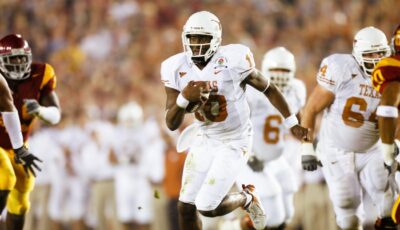
Film study: Auburn’s offense starting to become all that we thought it could be
By Ian Boyd
Published:
The 2016 Auburn Tigers were pretty close to excellence. They finished the year ranked 9th in defensive S&P+ and 32nd in offensive S&P+ and went 8-5 with their losses coming to Clemson, Texas A&M, Georgia, Alabama and Oklahoma. That’s life as an SEC West team, if you aren’t dominant your record probably won’t be either.
The Tigers’ calling cards were defense and a run game that nearly put Kamryn Pettway and Kerryon Johnson over 1,000 rushing yards (1,224 and 895, respectively). The plan for growth in 2017 depended on continuing to play great defense and running the ball while adding a passing element to put more points on the scoreboard. They tried to get there by hiring Arizona State offensive coordinator Chip Lindsey to bring more RPOs (run/pass options) into the offense and transfer QB Jarrett Stidham of Baylor to execute them.
Early results were a tad mixed and Clemson still shut them down, thanks largely to a withering pass rush that inflicted 11 sacks on Stidham and kept the passer from ever effectively pushing the ball down the field to relieve pressure off the run game. The Tigers rebounded reasonably well from that defeat and then they really opened up the floodgates against Mississippi State, winning 49-10 behind Stidham throwing for 264 yards and two TDs at 16.5 yards per pass attempt.
Building off the Auburn run game
The offenses that really put Gus Malzahn on the map as an offensive coach were the Cam Newton 2010 Tigers and the Nick Marshall 2013 team, both of which won the SEC championship and competed for the national title.
The Newton War Eagle offense was famous for popularizing the “power-read” play that turned the power run game into an option attack with a RB or WR attacking the edge and Newton serving as the ballcarrier on the downhill power trajectory.
Marshall’s offense was famous for using a new style of zone-read play in which the offense would “arc” a fullback or tight end around an unblocked DE to serve as a lead blocker for the QB if he kept the ball. Both offenses were devastating, but Auburn has lacked a good dual-threat signal-caller since to execute either scheme or any of the other popular QB running plays of today.
The 2016 offense was still effective running the football thanks to their use of fullback Chandler Cox as an H-back in spread sets to help pick off DL or LBs and run on defenses that didn’t bring an extra man all the way down into the box. The challenge was finding ways to punish teams that could bring help from their safeties without involving the QB as a runner. With Stidham at the helm the answer was obvious, with perimeter pass options attached to the runs.
Constraining the run game
One play that Auburn used to great effect against Mississippi State was an H-back lead play with a bubble screen attached from wide splits on the perimeter:
http://www.giphy.com/gifs/3o7aD136fQfTz8T5lK
The H-back Chandler Cox is leading off tackle on an inside zone run and creating a new gap on the edge, but first he feigns as though he’s inserting between the tackles. The Bulldogs are struggling to fill that gap without leaving holes between the tackles and the middle linebacker is hesitant to follow the H-back because of his initial movement and then gets caught by star right guard Braden Smith.
If the Bulldogs tried to defend the play by sneaking the nickel or outside linebacker in to protect the perimeter, then Stidham could punish them with the attached screen outside:
http://www.giphy.com/gifs/l378sNI6In9vSIqju
Malzahn has also been using an interesting new take on the zone-read play. Stidham is a mobile guy who can do some damage as a runner, but his better trait by far is his ability to make a quick read and accurate toss on the run.
They’d motion in a slot as an H-back and then put him on an arc path like they would their fullback, except they were using 5-9, 175-pound Ryan Davis and he wasn’t doing any blocking. Then they’d run zone-read and leave the DE unblocked like normal. If he stayed wide, it would be an inside zone handoff like normal.
http://www.giphy.com/gifs/3ohhwyTULjq5Vy1CG4
But if the DE turned his shoulders inside, then Stidham would attack the edge. But he’d do so with the quick pass to Smith in space rather than trying to race past defenders on the edge with his legs.
http://www.giphy.com/gifs/3ov9jSex7PYn5zgufm
With these quick passing elements added, it’s much more difficult for opponents to key in on the Auburn inside running game, much like when Newton or Marshall were around.
Going deep
The real damage to be done when you pair an effective run game and quarterback is still with play-action, and play action is the main reason Stidham averaged 16.5 yards per pass against the Bulldogs.
http://www.giphy.com/gifs/3o7aCR4zh2AEUFcw1i
The goal line is always an obvious place to run the ball, but instead the Tigers take advantage of MSU loading the box and giving WR Eli Stove so much room on the outside with a deep bomb.
The Tigers also manipulated the Bulldogs with some unexpected pass fakes on the edge:
http://www.giphy.com/gifs/3ohhwwViFX0v3bCtYA
http://www.giphy.com/gifs/l378yPhlBov6FeTgA
They show a “smash” hi-low combination which they’d already run earlier, but then instead of running the deep out, the slot receiver fakes out the safety and runs down the pipe on a post. Touchdown.
Of course the unsung hero in all of this is the Auburn OL, which bought Stidham a ton of time and room to step up on both throws. Nevertheless, the result is that the Tigers are finding ways to leverage having a passing QB and some talented WRs to be more than a one-dimensional offense.
Combine that with a great defense and perhaps Auburn can go from good to great this season.
Ian Boyd is a college football analyst who studies the strategies and tactics across the game. Follow or contact Ian on twitter @Ian_A_Boyd.







